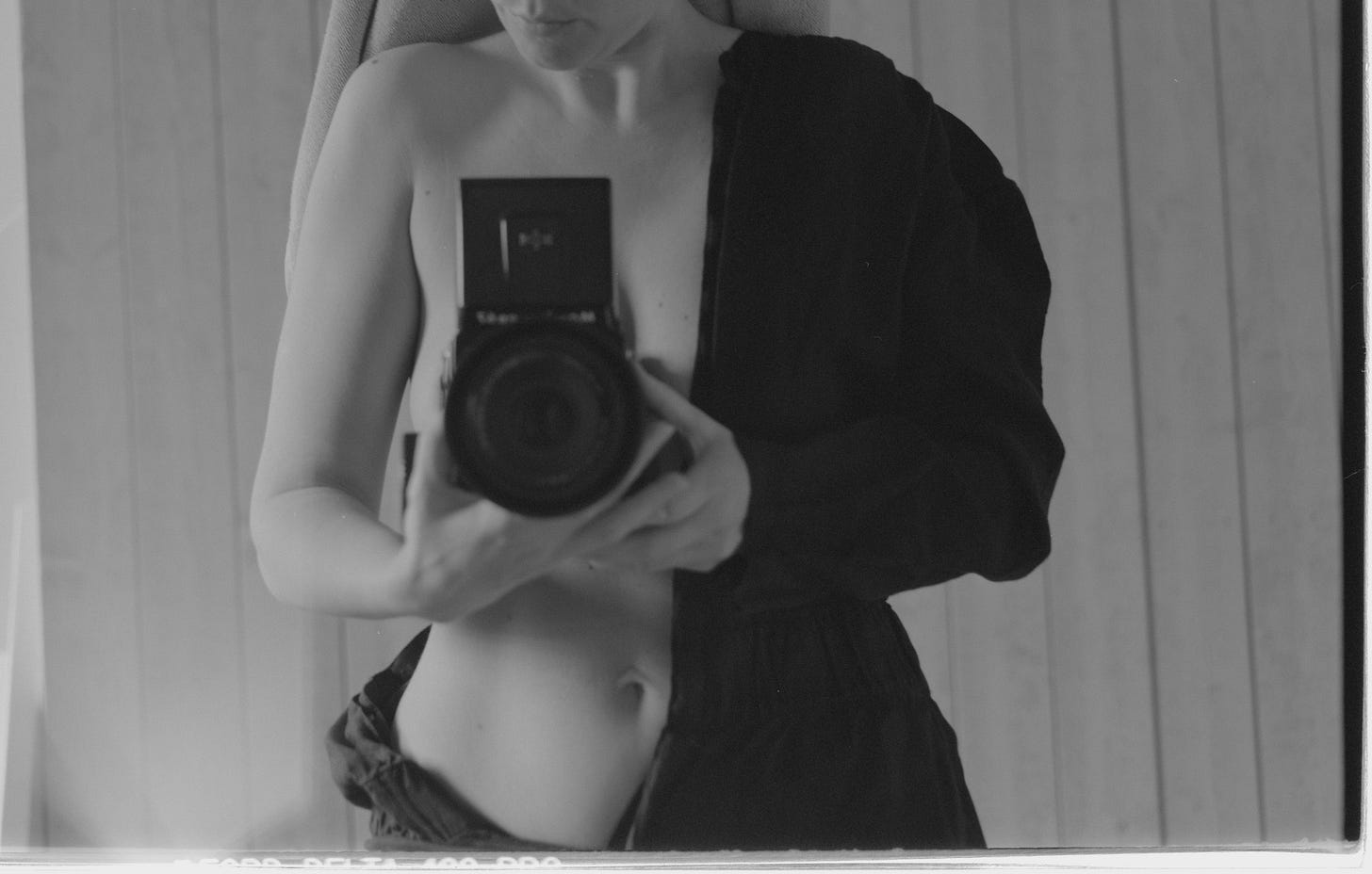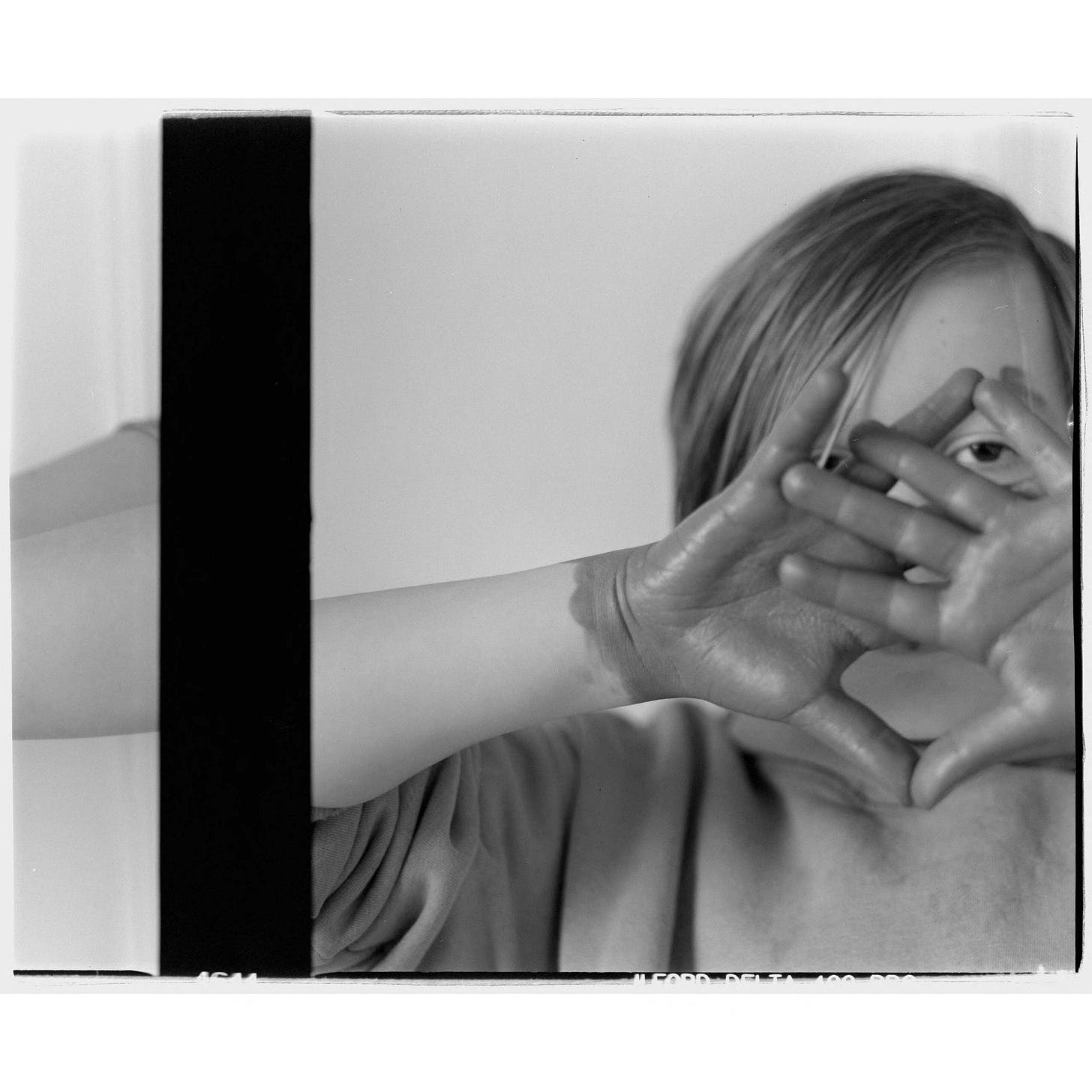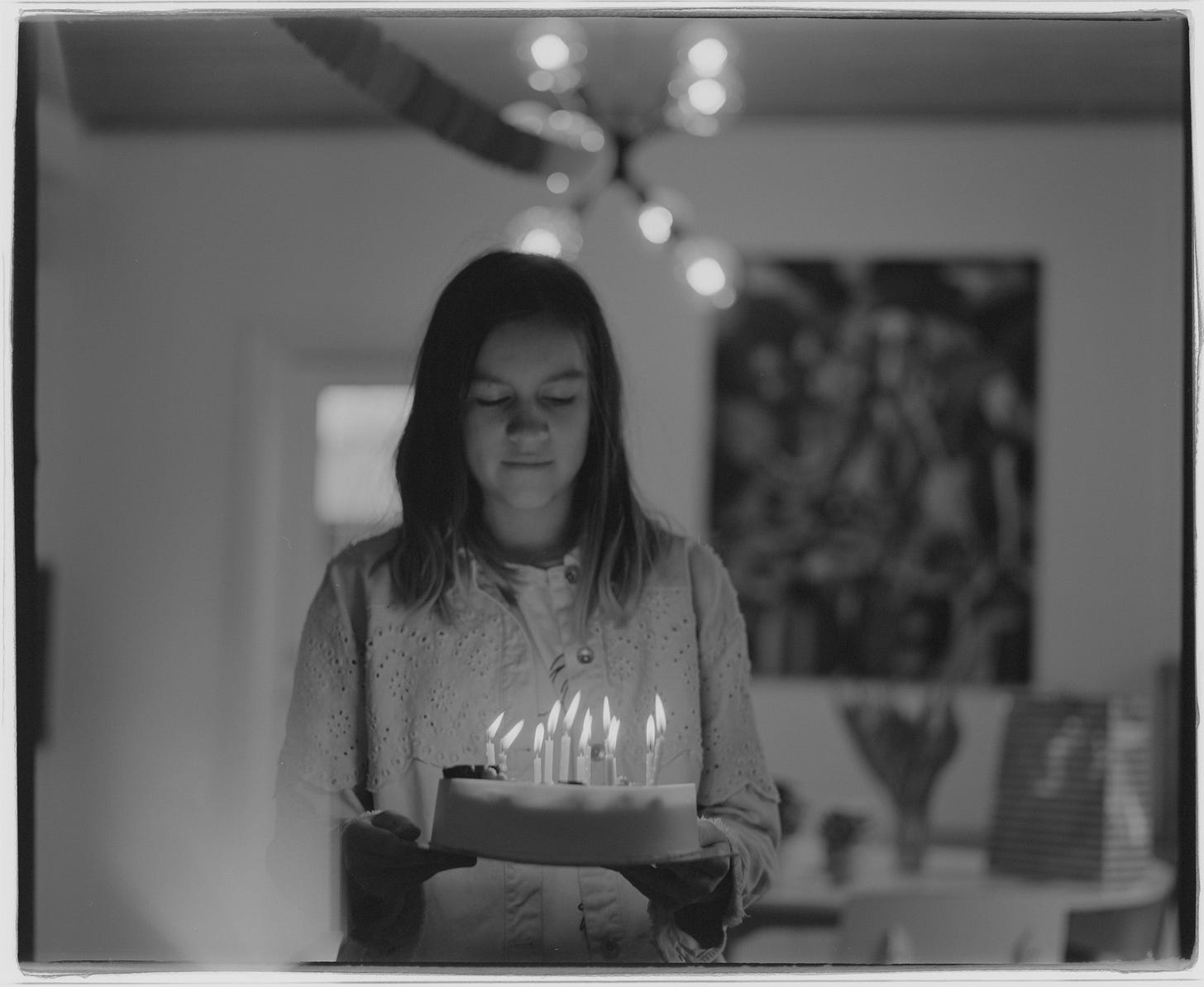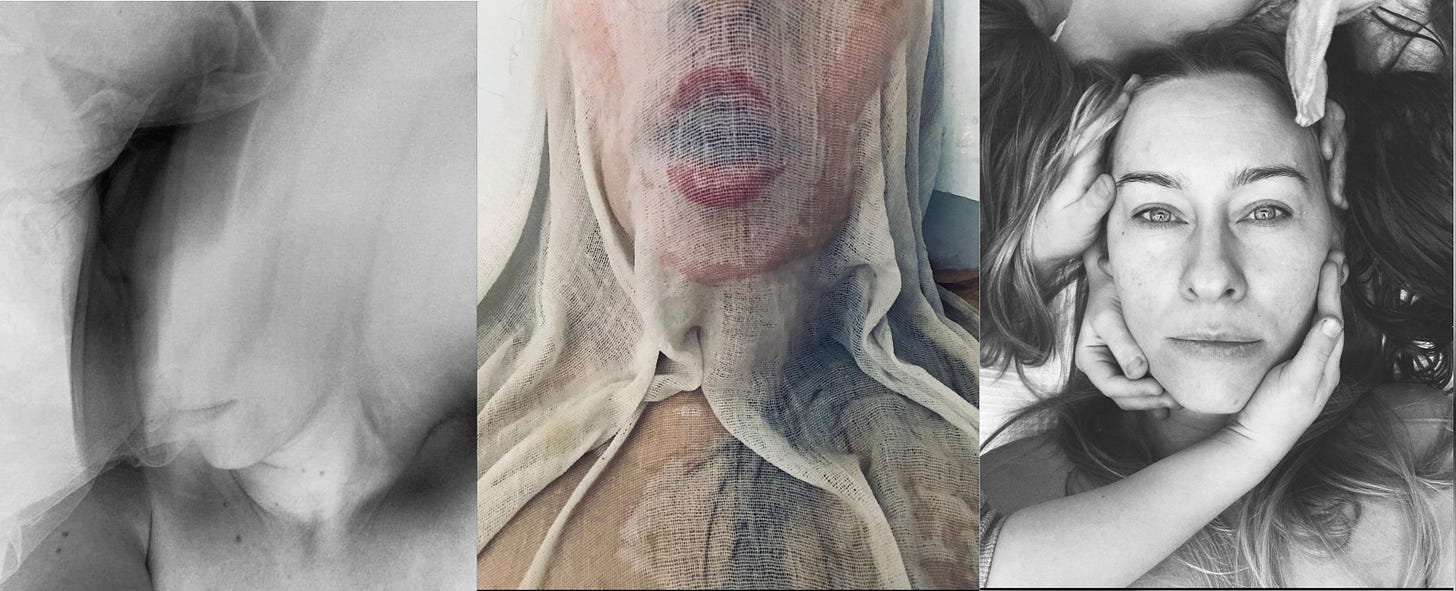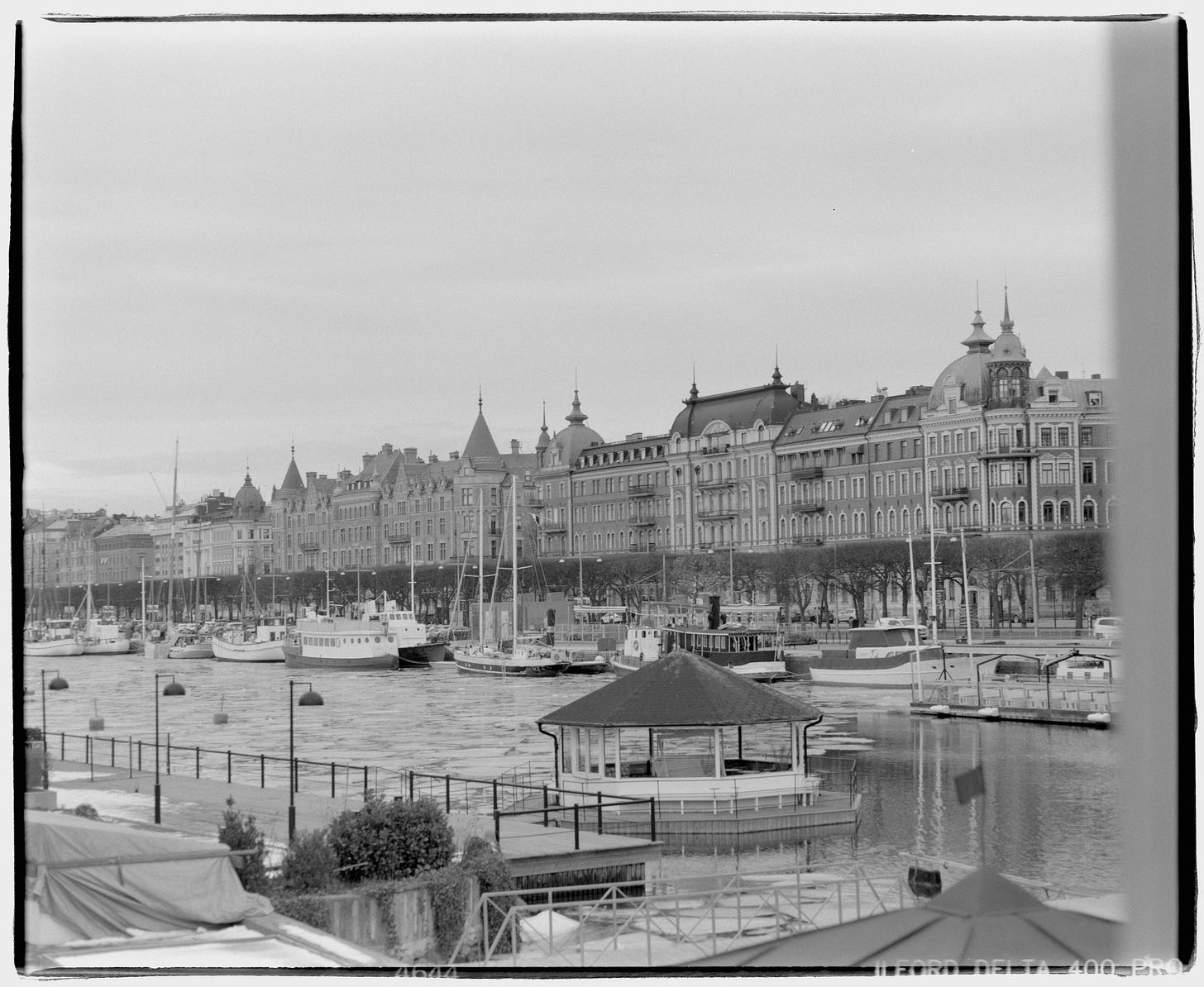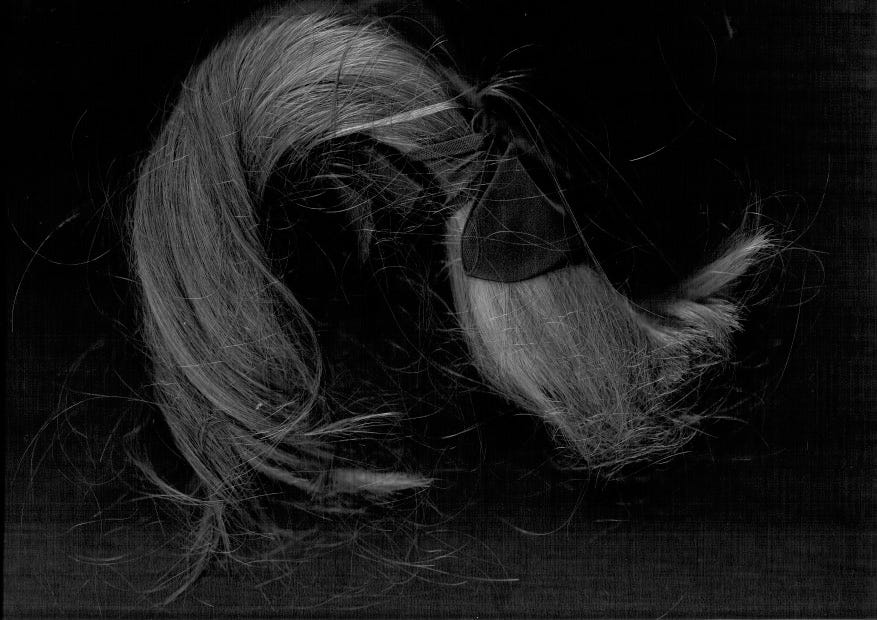I Want To See Me
Chatting with Tarantula: Authors And Art feature artist of June 2022, Kristina Aleksynaitè
If you are new or have landed on Tarantula: Authors and Art for the very first time, welcome to our monthly interview with our featured artist. Throughout June we have been so lucky to be witness to Kristina’s journey of self-discovery through photography and her own body; now you can meet the gauze draped woman behind the camera (and in front of it!) If a friend forwarded you this article, welcome; if you like it, share it or why not subscribe?
On a sunny day in June, photographer Kristina Aleksynaitè and I sat down for a good chat while our children ran around in circles and her husband Karolis made us a lovely lunch. Dear reader, I wish you could have joined us (perhaps someday we’ll start doing interviews as podcasts, who knows!) but grab a cup of tea (my usual) or coffee (Kristina’s) and read along... you’re in for a treat.
TARANTULA: So happy to be with you today, and on the summer solstice no less! For our readers at Tarantula what can you tell me about your journey to becoming a photographer? When did you fall in love with photography?
Kristina: I guess the beginning was my mom taking me to exhibitions. You know we lived in the Soviet era and so much was forbidden. You couldn't see a lot of art in your daily life so my mom would go to some galleries or museums. She was very interested in it always, so she started taking me to galleries and somehow we ended up often in the photography exhibitions.
So when did you first pick up a camera?
I was, 15 or 16 when I got my first. Everybody got film cameras in those days. I went to after school classes and we learned to do everything by ourselves. We would photograph, we would go to the dark room and do that whole process. It was long time ago, we didn’t have digital yet... so I started but you know, I chose a different profession - I forgot about photography.
But you became a journalist. Was there any photography involved in being a journalist?
When I was a journalist I had to find the picture, but usually I would ask some photographers for what I needed. I think how I started photographing professionally was as a culture journalist I would go to different events to write and to photograph a little bit.
So you were doing your own photography for the stories that you were writing?
Yes, and one time I went to Moscow to Eurovision! It was the main event, and I did really bad photos. I got this good camera from my editor and I couldn't use it properly. I used it like an automatic, and it had these beautiful good lenses. And you know, when I came back, it was all blurry and the shutter speed wasn't right. And it was dark, a lot of emotions, you know. So I decided I should learn! That was it, I went to some courses, and that's how it really started.
When I had my kids I experimented taking photos with them. But I'm a self-learner. I didn't go to art school, or to university. So I learned everything by myself or with some small courses. After that, when I was at home with my kids, and I was wondering, should I come back to writing but I noticed in myself that I enjoyed photographing more, and then I saved the writing for later. Somehow it just pushed all writing to the side, and photography went in front. It happened very naturally.
You wrote about how there are almost no pictures of you as a kid, and that’s hard. So I wonder, how does photography fit into your life with your kids? How does that work for you?
Well, at first I was obsessed with photographing them. Since I didn't have my pictures I always wondered, if I'm missing something, you know? I wonder, how was I? What did my cheeks look like? I don't know that because I can count my pictures on my two hands, and they’re from far away. You want to know yourself, and from all the stories, my mother or father tells, it's very different. I want to see me. So I started photographing everything, all the things. But suddenly after about three years I lost all my data. My little one just dropped the hard drive. Oh. And it was so traumatic for me! Of course we live in such a world where so many grandmothers photograph, right? And we had done some photo shoots of them. But, so many were gone – like from when I gave birth! Oh it was so hard, but after that I started looking differently at the pictures and that maybe I don't need so many. I don't need, you know, 100 pictures from one birthday, right? Just a few of them. I started to appreciate it more.
Still, I want them to see different perspectives on their childhood. Real life is not like when you do a photo shoot and everybody looks perfect in the picture. I want to photograph them from different angles, different sides. It doesn't have to be very pretty. I don't edit pictures of my kids or daily life. It's very important for me. Not so beautiful, you know? Sometimes we have dirty dishes and hair like we just got out of bed. I like it not dressed up. School portraits are fine and that's enough, but it's not our life. I like that I'm creating some kind of story of them, like I saw them, and I'm really seeing them in their childhood. Also, they are photographing. Selfies for them are fun, or they are filming. So it's their story - they can recreate and remember something.
Photography is such an interesting piece of modern memory, right? When I look back in my memory about my childhood, I very frequently see events through a picture, that somebody else took. My memory is so closely related to the photos. When I look back, I don't see the things that happened through my own eyes. I'm seeing it through the photograph of what somebody else saw of the moment. There are different kinds of memories like that. But I'm also remembering it as a kid, looking at the photo albums, and hearing the stories about what happened. Photography adds in another layer of how to hold onto those memories. It's different thinking about how you personally experience it versus how other people see you in that moment.
Right. In this moment, here’s something I wasn't seeing, or that's what it would feel like to see him... I was a very quiet kid, never caused problems, I sat quietly and played... and there is this experience of being you. My parents were working a lot, so my brother and I were quite independent - it was quite difficult to experience. So my kids, I want them to feel, to see, to be seen. I spend a lot of time with them. I asked my mom, why didn't they take a picture? But they just didn't think about it...
It was a very complicated time. Absolutely. I know you're a meditator. And so I wonder how photography does or doesn't fit with your meditative practice? Is it in any way a meditation to take a photograph?
Yeah, it is. I started TM - Transcendental Meditation, two years ago. So I'm noticing of course that I'm becoming more calm, and more calm in photographing. I changed my process of photographing. I went from digital, to film so everything slowed down. Before pushing the button you have to look for an angle, to be quiet, because you cannot run around and do film, right?
Right, it's not like digital where you can just take 10 and decide the best one.
I realize I'm very tired of doing photo shoots, photographing a lot of people or portraits, or for magazines. You work with stylists, with makeup artists, with hairdressers. You have to organize everything, and you run around and photograph. After a meditation though you see around what is interesting and you know, it's good, to look for a moment and wait for it. And it's not so nervous or not so hectic a process. Later you appreciate these pictures more and you see, when you come to the process in a more quiet and meditative state, the pictures become more beautiful and they have something deeper in them.
So I guess my perspective changed. And of course my photography changed a lot. Before I had my own portrait studio, and now I moved more to art, and even portraits I do now with kids are very different. I don't need so many colors, I don't need so much contrast. I like more natural.
So you're doing mostly black and white.
Yes, it's from my childhood. I remember the photographs I saw in galleries with my mom. They always were black and white. Also I guess it's because, when we moved to our home, I was six years old, and it was a very gray house. We had not so much furniture, and the floors were gray, cement I think. I would sweep and play - I would water it and watch the dust go up. Oh, it was quite interesting. We lived in such a gray, gray house I remember. It was so minimalistic, but in the same time, it was very beautiful. It's quite empty, but it's quite beautiful! Spacious and beautiful. I don't like a lot of things around. Very simple. Very few. Because when it's a lot I get tired. It's overwhelming and I cannot concentrate in too many things. Maybe that's why.
Wow, that beauty really stayed with you. I wonder what else you can tell me about your process? As in, technically, how do you do the self portraits? The artfully wrapped, wet gauze, your eyes are closed... you must have a remote, yes? And you still have to compose the image while the camera is over there somewhere. Yes? And all with film?
Yeah. But digital, not with film.
So you can take it and look and take it and look... but composing the picture? And you, while you're in it and...
...and it gets cold. Yeah. Yeah, yeah. (laughs)
So you're, wet, you're wrapped, in gauze, and you're naked? (laughs)
And it’s slippery! It's not so easy. (so much laughter!) Yeah. It may not be very easy at all. Okay, so it's a long process. Sometimes I get frustrated, so I have to stop it to meditate a little bit. I just see what is going on, you know, because I have to have the exact angle. I just appreciate that.
That would be a very complicated!
Yes. It's complicated! But you know I thought I just have to do it. I don't wait for inspiration. I just go and I see what I get this day. Sometimes you don't get anything. It doesn't look good or the light's not right.
So when you go to take a picture do you have ideas in your head about, well, here's the experiment I'm going to try today? Or do you have a picture in your head of what it is that you're hoping to get?
It's all an experiment, yes! When I started, I just took a picture. That’s how it started in this “Before Leaving” series. I was just making self-portraits during quarantine. It was a series of 40 days of photographing myself, with whatever things that were around. I photographed myself and I was noticing the feeling I had - like frustration - so I would go to the bath and take pictures with the thing I have. And one day I took gauze. I didn't know what to expect - I just started putting this gauze on me. It was very sculptural, and I saw that it was a very beautiful sculpture. And it said a lot, a lot of things.
I saw myself, very vulnerable and that's what I was, because I was just about to move to another country and it was very painful for me. Leaving it all, like I was in the ground, and then I thought I will stay in between forever. I saw everything in these pictures, I saw me as a mom and also all the things I've been, and I saw all that I'm experiencing. This gauze just helped me to express all this on film. We usually see this body or, you know, this face, but I didn't want it. I wanted something in between. Something that could let some ideas come and to show how it feels.
Yeah. Absolutely. Because the gauze is really transformative, right? I mean, the body is a sculpture, but when you put the gauze over it with the water, it definitely makes it more sculptural.
And more powerful expressions. You just feel the heart beating or I can feel the vulnerability. Somebody’s shapes, just talks about everything, you know? Because we have everything in our body. It stays with us, like in us we have all this memory. You know, I don't have all these pictures of me from childhood, but I'm still this child. All of us are. I can see in my, I don’t know maybe hands, but sometimes I see in my body that I'm like a child this moment. It’s still with me.
It's the same hands, right?
Same. Yes. It's the same hand. So I see this kid, who doesn't have any pictures, but now I can see, like a grown up, this kid...
And I wanted to know, to memorize this moment and what is going on with me, because it's a huge change. I was afraid of it. Immigration. So like a sculpture, you just memorize the shape of that moment because after a few days it'll change... I thought I will do a tryptic: before, staying, and leaving again. All the changes, you know?
Let’s focus on the staying for now... I know you've said that you are really loving being in Stockholm. After all the fear and being nervous about migrating, now you're here and it seems like it's wonderful for you.
Oh my God. Transformative! Imagine how big a change it looked for me because the first time I went to the capital from the second city where I was born, I was 17! I mean, I didn't travel at all. Can you imagine? Later of course, when I was a student, I traveled. The first time I flew on a plane, I was 22!
Wow! When did you go to the United States?
I was 23. It was the second time I flew. So you know how the world opened for me? I was raised in a very simple family and I never even dreamed about it. I was alright, sitting in the garden with family... Then I thought when I was living in Vilnius or traveling around somewhere for vacations, I thought: I'm a citizen of the world... But when I came here to Stockholm and I just met all these beautiful people in the international community... it's a very different world to open up! All the galleries we have here, I can go, every week to a new gallery and I can see something new! In Vilnius, you know everything.
Also what happened, I have more courage here. It looks like nobody knows me so I can experiment and do crazy things. This distance gives you self-confidence. I wouldn't dare show some pictures there. But here? Yeah. A different environment or some inspiration, I guess. And the self-confidence just grew up, you know? It's still growing. But I guess this is different. They say you cannot be a prophet in your own land...
My last question is just about what projects are you working on now or planning for the future?
I'm collecting a lot of things from the kids, teeth and hair, precious things, precious, secret, sacred things, you know, so I'm collecting and I have a lot of stuff, so I will photograph them. I want to, because they will always be with me but we cannot hold and carry on all these things forever. I thought I might photograph them somehow very special and then I will bury them in the countryside where we have a house. I think I shouldn't keep them. I have a lot of things, you know, but I'm holding on so I will try to leave it.
Also, I want to do a portrait series from the international community and the friends I've got here. I wanted to call it moving mothers, but I don't think that’s it. Something about mothers, who meet? The kids all go to the same classes, so you make friendships. But usually these families are expats who are moving from one country to another and so I want to show this relationship somehow. I want to express this relationship that is very sensitive because after few years... you have a friend and you know, you will lose them. They'll be moving away. You won't lose it, but you know, it's very temporary.
Yeah. It's a very unique experience to the expat community.
Nobody talks about it, you know? But so many people are living like this.
Let’s not talk about the leaving part… but I can't wait to see what you do next!
Thank you. You will see yourself in this picture.
I look forward to it all. Thank you!
** This conversation has been gently edited for length and clarity
To see more of Kristina’s photography and read the articles that were inspired by her art, go to our archives and browse through the whole of month of June!
Tarantula: Authors and Art is a reader-supported publication. To receive new posts and support our work, consider becoming a free or paid subscriber.




